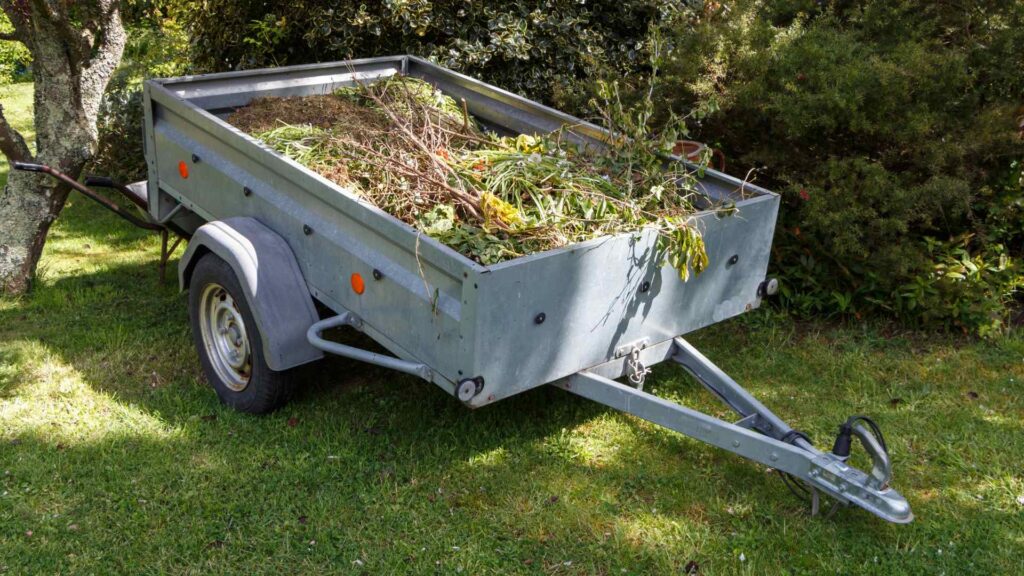How Treadwear Can Help You Select a Used Trailer
Eric Johnson2023-09-25T02:09:54-05:00
In This Article:
How Studying the Treadwear Is Crucial to Selecting the Right Used Trailer
First, It’s Natural for Trailer Tires Not to Wear Evenly
Low Tread Depth May Be More than a Sign of Usage
What Does Excessive Inner/Outer Treadwear on Trailer Tires Mean?
What Issues Are the Cause of Excessive Center Wear on Trailer Tires?
What If the Tires on a Used Trailer Are “Feathered?”
Pay Attention to Spotty or Patchy Trailer Tire Treadwear
Keep an Eye Open for Trailer Tire Camber Wear
Cupping Can Be Caused by Damaged or Worn-Out Suspension Parts
Age Is Another Factor to Be Aware of When It Comes to Trailer Tires
When You Need Trailer Tires, Count on Treadworld
How Studying the Treadwear Is Crucial to Selecting a Used Trailer
Buying a good used trailer shouldn’t be the hardest task in the world. And the money you save buying used instead of new can be significant—as long as you choose wisely, and don’t wind up with a lemon. That’s why when it comes to choosing the best trailer, a used utility trailer, a used cargo trailer or a used travel trailer, you can unlock some important secrets by studying the treadwear to help you identify issues that might not otherwise be readily visible to the eye. The tire experts at Treadworld are here to explain what irregular tire treadwear can tell you about needed repairs and maintenance, to help you make your best used trailer decision. If your prospective trailer’s tires have a story to tell you, it will be a plus for your wallet to listen.
First, It’s Natural for Trailer Tires Not to Wear Evenly
In a perfect world, every tire on your trailer would wear evenly, and exhibit the same wear patterns at any given time. But it’s not a perfect world, and simple physics tells you that trailer tires do not, and cannot, wear evenly—if only because they hold different positions, and therefore endure different stresses, caused by potholes, for instance. Or caused by turns, which result in the inside tires having a shorter distance to travel, which might lead them to slide instead of roll, creating scuffing.
While the irregular tire wear we pinpoint below could have been caused by overinflation, underinflation, an overloaded trailer or poor driving habits—issues you don’t really need to worry about when you’re considering a used trailer purchase—it can also be a sign of a worn-out suspension, alignment issues or other mechanical issues that should make you hesitate before you plunk your dough down for that new, used trailer, because those issues will likely cost you down the road (no pun intended.)
Low Tread Depth May Be More than a Sign of Regular Use
You know of course that as tires are used, the tread wears and gradually becomes shallower. That’s not unexpected. And you also likely know that excessively worn tire tread depths can lead to unsafe driving conditions because when tires can no longer adequately grip the road, it’s easier for control to be lost—especially when roads are wet or snow-packed. To determine tread depth, you can use the built-in tire tread depth indicators found within the tread grooves of many tires, you can use a tread depth tool, or you can use a penny. When conducting a penny test, place the penny with Lincoln’s head upside down into the tread groove. If you can’t see the top of Lincoln’s head, the tread is at least 2/32-inch deep at that location—the minimum. If Honest Abe’s whole head is visible, your tire is living on borrowed time, and should be replaced.
But the real question here is “what caused the excessive treadwear?” It could be that the previous owner often hauled the trailer with over inflated tires or under inflated tires, but it could be a sign that the alignment is off and needs to remedied. Each axel should be aligned with the front of the trailer, but should also be parallel to the other axel. Proper alignment is an adjustment of the vehicle’s steering and suspension components—the system that connects and controls the motion of the wheels. It is not an adjustment of the tires or wheels themselves. The key to proper alignment is essentially an adjustment of the angles of the tires and their contact with the road.
What Does Excessive Inner/Outer Treadwear on Trailer Tires Mean?
Excessive inner wear or outer wear on trailer tires could be a sign that the trailer has been often overloaded in the past, that the tires have been under or over-inflated, or even that the previous owner liked to take corners too fast, and make sharp turns. But it can also suggest worn out or damaged suspension components or improper alignment. Trailer axles are built with a slight upward curve in the middle causing the tops of the tires to lean slightly outward when the trailer is unloaded. When the trailer is carrying a load, the axles straighten to a flat position and the tires come to a straight up-and-down position. If that load is too heavy, the axle bows downward in the middle, causing the tires to roll more towards the inside shoulder, leading to more pronounced wear.
If you’re seeing just one tire wearing faster on the inside, that can indicate a bent suspension part, like a spindle, which can cause one tire to skid rather than roll smoothly down the road, creating heat and friction that will eventually wear out the rubber.
What Issues Are the Cause of Excessive Center Wear on Trailer Tires?
The most likely culprit for one or more trailer tires showing excessive wear down the center is overinflated tires, though consistently pulling an underloaded trailer, and driving habits that include frequent high speeds and lots of hard braking can also be a cause. But center wear also be a sign of Improper alignment, which can cause the center of the tread to wear out faster than the rest of the tire. Or it could be worn or damaged mechanical components, such as bearings or brakes, that are causing the trailer tire to wear out unevenly.
What If the Tires on a Used Trailer Are “Feathered?”
Also called “scuffing,” feathering tread wear is when a tire wears down at an angle with one side worn lower or smoother than the other side. A feathered tire will have sharp edges on one side, and rounded edges on the other. It’s harder to catch with a visual inspection, but when you run your hand along the tread, you’ll be able to tell. While feathering can be caused by tire inflation issues or poor driving habits, it can also be caused by a variety of problems with the trailer’s suspension— such as damaged or worn bushings or ball joints—that can lead to misaligned wheels. Generally, the toe-in of the wheels, if out of spec, will cause scuffing that leads to feathering. If you see feathering on a trailer you’re considering buying, it’s important to identify the root cause so you’re not stuck with further damage down the line.
Pay Attention to Spotty or Patchy Trailer Tire Treadwear
As with most of the aforementioned treadwear issues, spotty, patchy wear between the outside edges and center of the tread can be the result of improper inflation or poor driving habits. But often, it’s an indication that the trailer’s wheels are out of balance, something that can be the result of wheel lockups, skidding or uneven road conditions. Out of balance wheels tend to wobble, creating an unsafe towing environment.
Keep an Eye Open for Trailer Tire Camber Wear
Camber treadwear on trailer tires refers to a type of tire wear pattern that is characterized by excessive wear on one side or the other of the tire’s tread, creating a diagonal or angled pattern that can lead to wheel lean. If the tire is tilting inward or outward, it can cause excessive camber and wear on one side of the tire’s tread. Again, excessive camber tire wear can be caused by overloading, and poor driving habits, but it can also be a sign of poor alignment, broken or worn suspension components or a bent axle.
Cupping Can Be Caused by Damaged or Worn-Out Suspension Parts
Cupping, also referred to as scalloping, is when the tire tread moves from high to low in random spots, almost like dips or craters out of the rubber tread. It occurs when the trailer is bouncing up and down excessively. The trailer literally loses contact with the road for short periods, and over time, this action creates noticeable “cups” in the tread. While it can be the result of excessive heat caused by going over the tires’ speed rating, it’s more likely to be caused by improperly balanced tires, wheel bearing problems, poor alignment or bad shocks or struts, especially on travel trailers.
Age Is Another Factor to Be Aware of When It Comes to Trailer Tires
Even if you’re not seeing excessive or irregular treadwear on tires of the pre-owned trailer, you would still do well to try to determine each tire’s age. That’s because statistics suggest the average life of a trailer tire is about five years with normal use and maintenance conditions, and that tire replacement should often be considered after three years, even if the tires appear to have adequate tread depth. That’s due to the not always readily visible effects of the issues mentioned above, but also because exposure to sunlight, moisture, extreme temperatures, and sporadic use of the trailer leading to long periods of inactivity can lead to a breakdown of the rubber.
The bottom line—Since you don’t want to make a used trailer purchase, only to have sink a bunch of money into getting it up to snuff with repairs or maintenance, it’s a good idea to take a hard look at the treadwear of the trailer’s tires, and determine the cause of any irregular wear you see. Whether tire wear patterns suggest something as simple as frequent overinflation or underinflation, or point to a more serious problem with the trailer’s suspension or alignment, by understanding what you’re seeing, you’ll be better able to determine the overall health of your trailer, and whether it’s worth your money.
When You Need Trailer Tires, Count on Treadworld
When you’re looking for new trailer tires, wheel and tire packages, or a spare trailer tire, count on us here at Treadworld to provide you with the high-performing, long-lasting trailer tires you want, in a wide range of styles and a huge selection of sizes. All our RubberMaster Trailer Tires are manufactured to strict tolerances from top rubber compounds, then triple-tested for quality, balance and uniformity before being X-rayed to be sure they’re perfect. All our dent-proof, crack-proof and virtually indestructible SteelMaster Wheels are manufactured from tough, durable steel then put through several quality checks to provide you with dependable quality. Expect easy ordering, and fast shipping, plus your satisfaction is guaranteed with our no-hassle Ultimate Advantage Warranty. Don’t hesitate to contact our tire experts via live chat or email with any questions you may have, and to get the ideal trailer tires—or the perfect ATV tires, UTV tires, lawn and garden tires, and many others—from our extensive selection. Or use our Treadworld Product Selector Tool to help you find exactly what you want.
